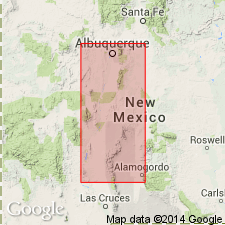
- Usage in publication:
-
- Bruton formation
- Modifications:
-
- Named
- Dominant lithology:
-
- Shale
- Limestone
- AAPG geologic province:
-
- Orogrande basin
Summary:
Named as "lower part" of Fresnal group (new) of Virgil series for Bruton Tank on northeast side Oscura Mountains, NM. Type locality is section measured in Fresnal Canyon along Hwy 83 east of La Luz in north end Sacramento Mountains; exposures in roadcut, NW1/4 sec 30, T15S, R11E, Otero Co, NM in Orogrande basin. Is 110 ft thick at type [measured sections shows 113.5 ft thick] and composed largely of soft, red shales with interbedded nodular limestones; all break down easily into slope. At type overlies Moya formation of Keller group (both new) which forms prominent rock terraces from foothills to northeast of Oscura Mountains; underlies unconformably massive basal Permian (Wolfcamp) limestones which support overlying cliffs and steep slopes of Abo red beds [formation]. In some areas Abo lies directly on Bruton due to erosion. [Stratigraphic chart suggests unnamed part of Fresnal overlies Bruton.] Bruton forms the slope between limestone terrace below and massive limestone cliffs above. Found from east-central part Oscura Mountains northward through Lomo de las Canas, Los Pinos Mountains, Abo Canyon, Manzano Mountains, and Sandia Mountains; also in areas along Rio Grande Valley. In eastern part of Oscura Mountains grades southward laterally into lower part of Fresnal exposed in Mocking Bird Gap. Fossiliferous, with brachiopods, bellerophon gastropods, and fusulinids, latter of genus TRITICITES. Is Pennsylvanian (Virgil) age.
Source: GNU records (USGS DDS-6; Denver GNULEX).
For more information, please contact Nancy Stamm, Geologic Names Committee Secretary.
Asterisk (*) indicates published by U.S. Geological Survey authors.
"No current usage" (†) implies that a name has been abandoned or has fallen into disuse. Former usage and, if known, replacement name given in parentheses ( ).
Slash (/) indicates name conflicts with nomenclatural guidelines (CSN, 1933; ACSN, 1961, 1970; NACSN, 1983, 2005, 2021). May be explained within brackets ([ ]).

